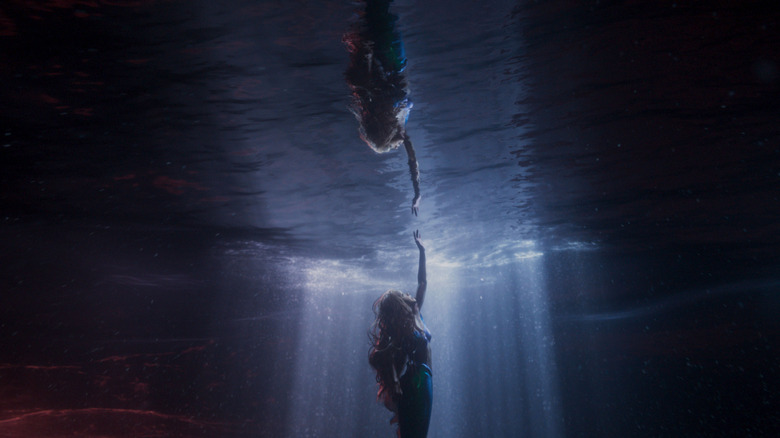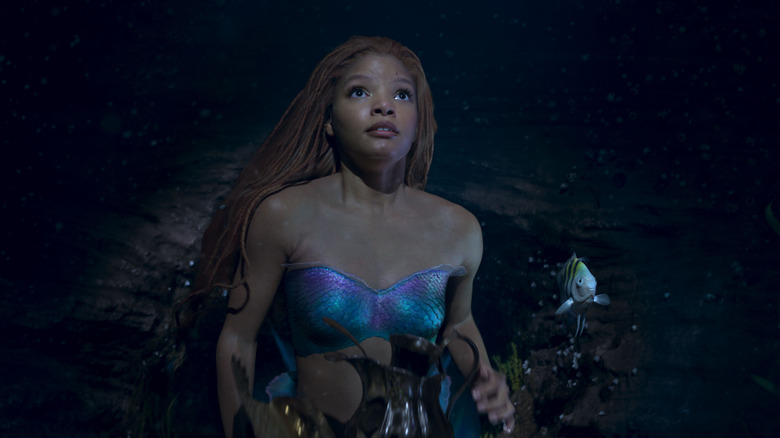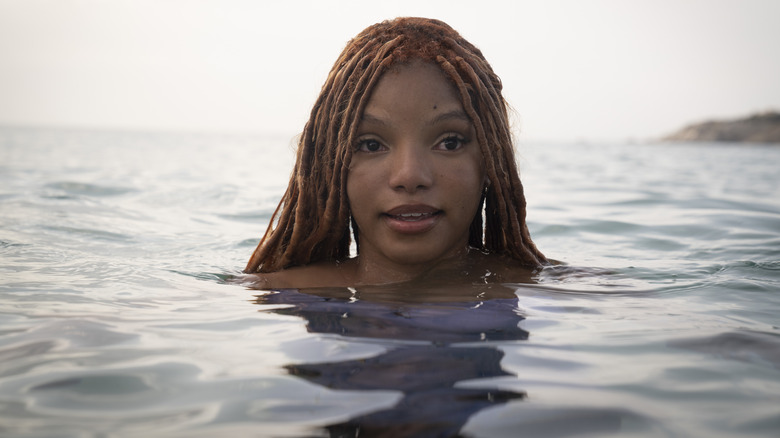Dry For Wet, Or How The Little Mermaid Was Filmed More Like Aquaman Than Avatar: The Way Of Water
Disney's live-action version of their 1989 animated film "The Little Mermaid" is just about to hit theaters and involved the challenge of shooting actors underwater. Drawing mermaids is (relatively) easy, but actual humans like to breathe oxygen now and then. So demanding, right? Unlike "Avatar: The Way of Water," which shot underwater scenes in actual water ("wet-for-wet"), "The Little Mermaid" used a similar technique to "Aquaman" in that they did most of their "swimming" in the air in harnesses ("dry-for-wet").
Having seen a screening of the film — and watched all the trailers like everyone else — I can say that while you can see a bit of a difference, it's fairly close outside of the hair. I definitely noticed some odd hair CGI in the dry-for-wet films, particularly King Triton's (Javier Bardem) flowing mane. Still, it's pretty miraculous that a bunch of actors on wires made it look like they were not only swimming but breathing and existing under the sea. (Look, I would like to say I'm sorry for using that phrase, but I'm really, really not.)
Let's dive in (okay, that one I apologize for) and explore how both techniques are done.
Wet-for-wet
Filming underwater is a little rough for humans. For "Avatar: The Way of Water," director James Cameron had his cast learn freediving, shooting wet-for-wet, with the actors in actual water. I got a chance to experience this with the film's Marine Unit and consultant Kirk Krack at a recent Los Angeles press event. We were taken through the techniques they used to teach the actors to ignore their body's signals to breathe, and I made it to two-and-a-half minutes on land (though I suck at it in the water). It's not something to try at home, and even though Kate Winslet managed to hold her breath for seven minutes and 14 seconds, she had taken in a mix of oxygen and other gasses to allow her to do this.
It took a lot of training, and Krack was in every underwater scene (though you can't see him) as a safety precaution. So why would they do something so complicated? Well, "Avatar: The Way of Water" didn't just have humans playing humans. The actors were playing Nav'i and using motion capture in addition to having all the creatures in each scene. When you use scuba gear underwater, the bubbles that result show up on camera in the same way the little motion capture dots on the actors do. That makes it pretty difficult for digital artists to render movement. Freediving has the actors holding their breath, so there are very few bubbles to get in the way. Add in the fact that Cameron is an advocate for saving our oceans, and you can understand his feelings on this.
Dry-for-wet
For "The Little Mermaid," most of the underwater scenes were shot with the actors in harnesses in the air. I attended the press conference for the film where Melissa McCarthy, who plays Ursula the sea witch, explained that her feet didn't touch the ground during the shoot. She said:
"I was never literally on my feet, we were either up in rigs, or there were all different magical things. [...] If you were diving, it was one rig. If you were spinning, it was another ... But no, never on the ground. And this amazing team of dancers and stunt people that just kind of were our fins or feet, however, you want to say. So each person had its team, this wonderful, glorious ensemble."
In addition, Halle Bailey, who plays Ariel, said in a video on her YouTube channel:
"Filming underwater was so much fun, but it was kind of brief, honestly, because most of the time I was on wires and in the air and in what they called a 'tuning fork,' where I would swim in the air and kind of simulated being in Ariel's Grotto and everything, so that's where I spent most of my time. But for the times when I would be underwater, it was crazy. I was in this huge water tank, and it was like they had this wave machine that would go, and I can't wait until you guys actually see it, so you know what I'm talking about, but it felt like I was in the middle of the ocean."
It's the same technique they used in "Aquaman," with the same sort of tuning fork rigs, as you can see in a video from Frame Focus, which shows some behind-the-scenes footage of the actors in harnesses. Honestly, either way, it's not that far off from reality in terms of looks.
"The Little Mermaid" will hit theaters on May 26, 2023.


